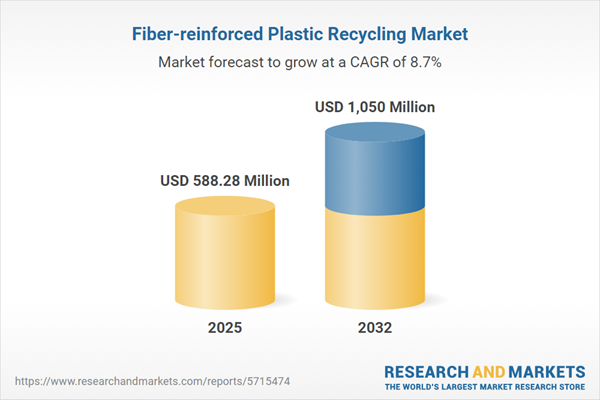Speak directly to the analyst to clarify any post sales queries you may have.
Fiber-reinforced plastic recycling is increasingly recognized as a strategic priority for enterprises pursuing sustainable growth, operational continuity, and regulatory compliance. As executive mandates consolidate around responsible resource management and resilient supply chains, decision-makers look to advanced recycling initiatives to future-proof their organizations.
Market Snapshot: Fiber-Reinforced Plastic Recycling Market Size and Growth
The global fiber-reinforced plastic recycling market is projected to advance steadily, with a valuation of USD 541.34 million in 2024. Growth is anticipated to reach USD 588.28 million by 2025 and approximately USD 1.05 billion by 2032. The compound annual growth rate (CAGR) stands at 8.73%, signaling enduring momentum.
Progress in this sector is powered by evolving regulatory landscapes, ambitious sustainability targets, and expanded investment in high-performance recycling technologies. These dynamics are helping industry leaders reduce dependency on virgin inputs, drive value chain improvements, and remain in step with global policy expectations.Scope & Segmentation: Fiber-Reinforced Plastic Recycling Market
- End Use Industry: Procurement of recycled fiber-reinforced plastics spans sectors such as automotive, transportation, construction, infrastructure, marine, aerospace, and wind energy. Organizations in these fields increasingly require reliable, certified recycled materials with proven mechanical performance to integrate into demanding operations while meeting environmental commitments.
- Product Type: Recycled product flows encompass both thermoplastic and thermoset composites, including engineered forms like plates and sheets. This breadth supports deployment across diverse applications, especially where durability and long lifecycle are prerequisites.
- Fiber Type: Segmentation centers on aramid, carbon, and glass fibers. Each fiber type brings specific benefits and recycling challenges; consistent quality is critical for applications subject to rigorous industry standards and material certifications.
- Recycling Process: Processes such as chemical depolymerization, solvolysis, mechanical separation, incineration, and pyrolysis are used. Process choice is shaped by local technical expertise, energy availability, and compliance requirements, which influence operational complexity and output quality.
- Regions: The Americas, EMEA, and Asia-Pacific present unique regulatory frameworks and market maturity. Organizations must adapt to distinct compliance guidelines and logistical considerations in each region to optimize distribution and regulatory responses.
- Leading Companies: Key suppliers include ELG Carbon Fibre Ltd., Conbility GmbH, Carbon Conversions, Inc., SGL Carbon SE, Solvay S.A., Umatex Holding S.A., and Pyrowave Inc. These organizations set industry benchmarks, accelerate process innovation, and facilitate adoption by standardizing recycled material quality and enhancing traceability.
Key Takeaways: Strategic Insights for Decision-Makers
- Enhanced traceability in recycled supply chains delivers real-time oversight, supporting procurement and compliance teams concerned with auditability and material origin verification.
- Automation and advancements in recycling methods yield uniform quality, driving procurement efficiencies and supporting consistent, cross-sector utilization.
- Scalable recycling capacities empower organizations to adjust to regulatory changes and shifting sector demand, supporting responsiveness and operational continuity.
- Strong collaboration between manufacturers, recyclers, and technology providers fast-tracks the development of closed-loop systems, building additional supply chain resilience and supporting long-term sourcing strategies.
- Focused quality assurance strengthens supplier relationships, helping organizations secure reliable material inputs and align sourcing with sustainability and performance objectives.
Tariff Impact: North American Policy Shifts
U.S. tariff adjustments affecting fiber-reinforced plastics are leading North American enterprises to reconsider sourcing strategies. This has prompted a renewed focus on bolstering domestic recycling infrastructure and integrating supply networks to effectively manage policy and regulatory shifts.
Fiber-Reinforced Plastic Recycling Market Methodology & Data Sources
This assessment is grounded in expert interviews, reviewed sector-specific reports, patent and technology analysis, and trade data. Engagements with industry stakeholders provide a comprehensive and nuanced understanding of current developments and deliver practical narratives tailored for executive decisions.
Why This Report Matters
- Executives are equipped to benchmark strategic recycling models, identify operational improvement opportunities, and remain alert to regulatory updates impacting the fiber-reinforced plastic recycling market.
- Outcomes include higher reliability in material sourcing, improved supplier collaboration, and actionable progress toward defined sustainability initiatives.
- Access to targeted market intelligence enhances risk mitigation and enables a proactive response to evolving industry and regulatory landscapes.
Conclusion
This report empowers leaders to identify new growth opportunities, reinforce compliance efforts, and strengthen organizational resilience for sustainable advancement in fiber-reinforced plastic recycling.
Additional Product Information:
- Purchase of this report includes 1 year online access with quarterly updates.
- This report can be updated on request. Please contact our Customer Experience team using the Ask a Question widget on our website.
Table of Contents
3. Executive Summary
4. Market Overview
7. Cumulative Impact of Artificial Intelligence 2025
Companies Mentioned
The companies profiled in this Fiber-reinforced Plastic Recycling market report include:- ELG Carbon Fibre Ltd.
- Conbility GmbH
- Carbon Conversions, Inc.
- SGL Carbon SE
- Solvay S.A.
- Umatex Holding S.A.
- Pyrowave Inc.
Table Information
| Report Attribute | Details |
|---|---|
| No. of Pages | 188 |
| Published | November 2025 |
| Forecast Period | 2025 - 2032 |
| Estimated Market Value ( USD | $ 588.28 Million |
| Forecasted Market Value ( USD | $ 1050 Million |
| Compound Annual Growth Rate | 8.7% |
| Regions Covered | Global |
| No. of Companies Mentioned | 8 |









